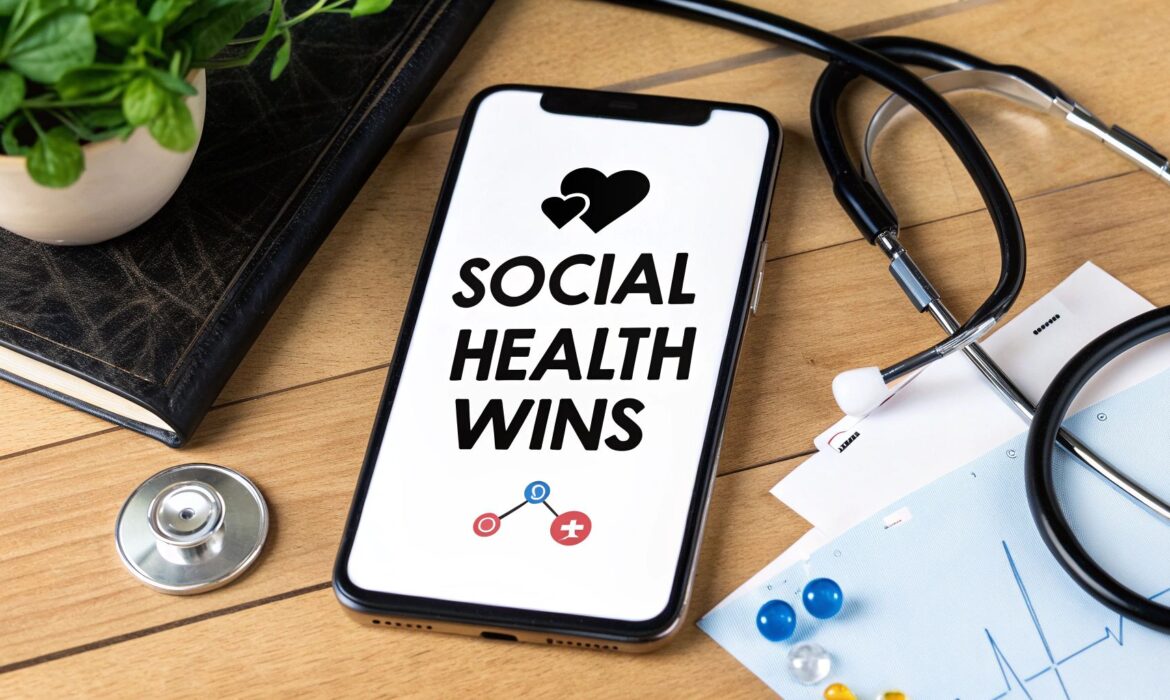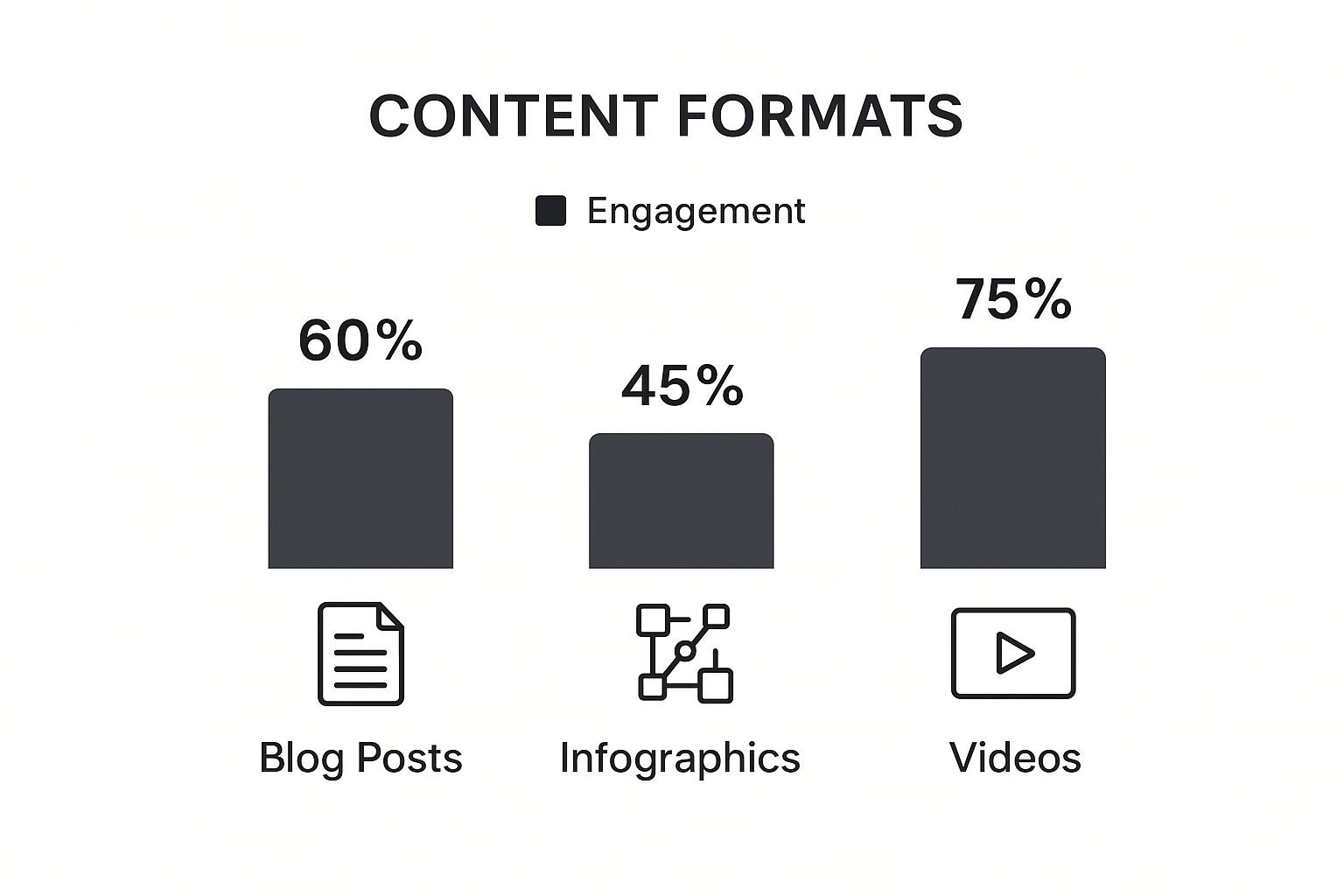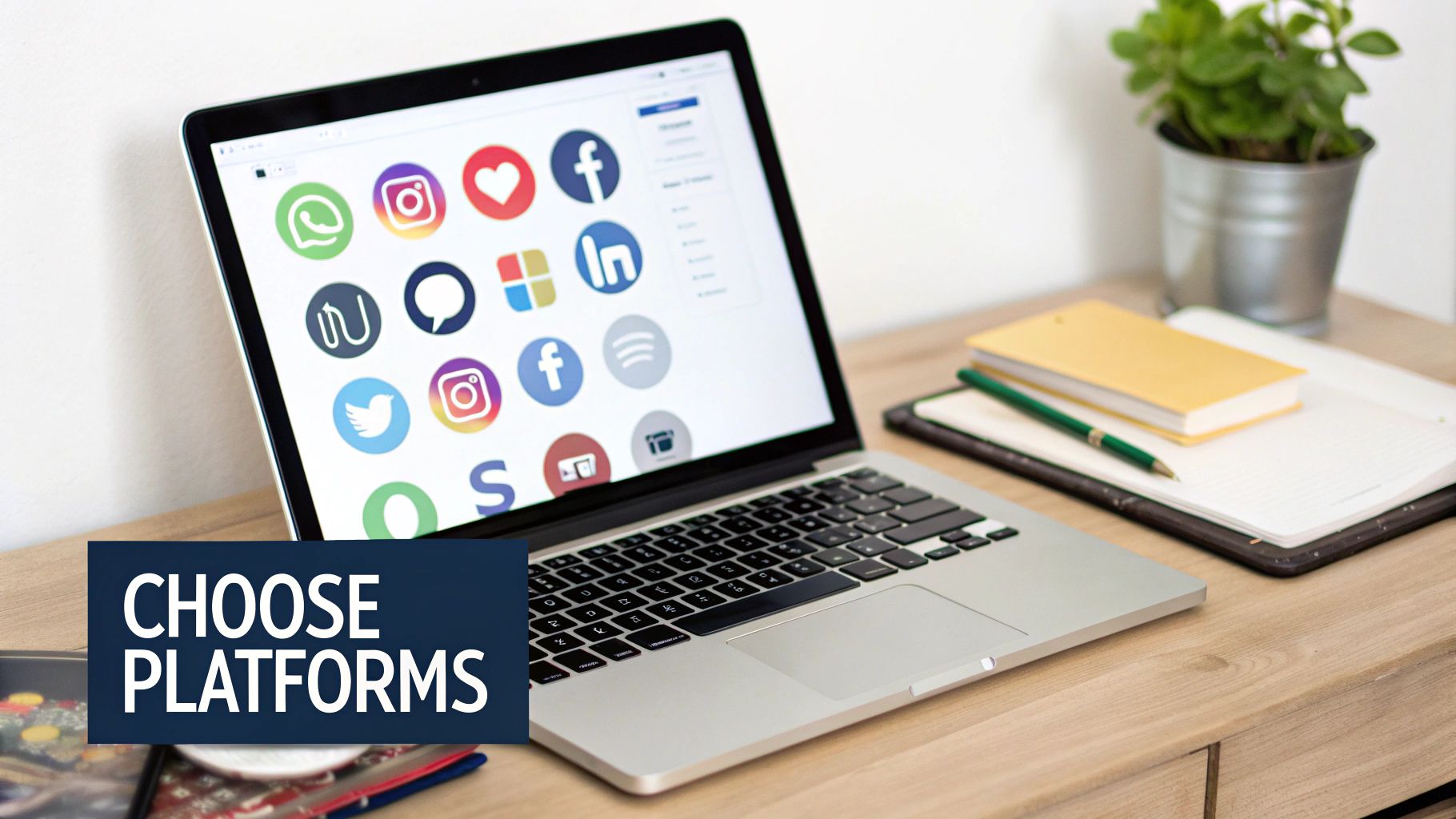
Let's be honest: healthcare social media marketing isn't just about posting occasional updates. It’s the art and science of building a digital bridge between your practice and the community you serve. It’s about creating and sharing valuable, trustworthy, and empathetic content that educates patients, builds rock-solid trust, and promotes public health where people are already spending their time—online.
Table of Contents
ToggleWhat Is Healthcare Social Media Marketing, Really?
Move past the idea of it being a simple promotional tool. True healthcare social media marketing is a core strategy that makes your practice feel more human and approachable in a world where everyone turns to Google for answers. This isn't about flashy ads; it’s about nurturing real connections and establishing your clinic as a go-to source of reliable health information.
Think of it like this: a billboard on the high street can tell people your clinic exists. But a well-managed social media profile can introduce your compassionate staff, break down a complex medical procedure into simple terms, and answer common health questions in real-time. This digital-first approach is no longer a "nice-to-have." It's essential for any modern provider who wants to connect with patients authentically.
The Core Mission of Healthcare Social Media
At its heart, this strategy is so much more than just marketing. It plays several critical roles that directly influence patient trust and your organisation’s growth. The ultimate aim is to shift perceptions from just being another provider to becoming a trusted health partner for life.
This strategic pivot is especially important in rapidly growing markets. For instance, the Indian healthcare sector is projected to hit around USD 600 billion by 2025, a huge jump from USD 372 billion in 2023. This growth is being driven by digitalisation and government initiatives like the Ayushman Bharat Digital Mission, making a strong digital presence non-negotiable for every healthcare marketer. To get a better sense of this trend, you can find out more about the Indian healthcare market outlook and its digital trends.
A thoughtful social media presence transforms a clinical practice from a name on a building into a living, breathing part of the community. It’s where empathy, education, and accessibility meet.
This table breaks down the essential roles social media plays for modern healthcare organisations.
| Function | Description | Example |
|---|---|---|
| Educate | Simplify complex medical topics, debunk common health myths, and share practical preventative care tips. | A short video explaining the difference between a cold and the flu, or an infographic on early signs of diabetes. |
| Empower | Give patients the confidence and knowledge they need to take an active role in managing their own health. | A blog post on "Questions to Ask Your Doctor" or a live Q&A session with a specialist on Facebook. |
| Engage | Create a two-way conversation, listen to community health concerns, and build lasting relationships. | Responding to comments on a post, running a poll about local health priorities, or sharing patient success stories (with consent). |
By focusing on these functions, you can move your social media from a simple broadcast channel to a powerful engine for public health awareness and patient loyalty. It cements your status as an authoritative, yet approachable, leader in the community you serve.
Navigating the Rules of Trust and Compliance

In the world of healthcare social media marketing, trust isn’t just a nice-to-have; it's the very foundation everything is built on. While other industries can afford to play fast and loose with their marketing, healthcare operates under a strict set of non-negotiable rules. These regulations are there for a reason: to protect patients and uphold the credibility of the profession.
Think of it like being a chef in a five-star restaurant. You have all the creative freedom to design an amazing menu, but you must follow strict hygiene and food safety standards. One mistake doesn't just earn you a bad review; it can have serious health consequences. In the same way, every single social media post you create must be both engaging and completely compliant.
This all starts with patient privacy. It's paramount. Global standards like the Health Insurance Portability and Accountability Act (HIPAA) in the U.S. have set a high bar for protecting patient data, but the core principles of privacy and consent are critical everywhere. An accidental tag in a photo or a casual mention of a patient’s journey, even with the best intentions, can spiral into a serious breach of trust and law.
Upholding Patient Privacy and Confidentiality
One of the easiest traps to fall into with healthcare social media is accidentally sharing Protected Health Information (PHI). This isn't just a patient's name; it's any detail that could potentially identify them, from photos and treatment dates to unique medical conditions.
Sharing a patient's success story can be incredibly powerful, but it demands an ethical, by-the-book approach. A quick verbal "okay" is nowhere near enough. You must get explicit, written consent that clearly spells out what information will be shared, on which platforms, and for how long. This document is your shield, protecting both the patient and your practice.
Let's look at a common scenario: a clinic wants to post a testimonial.
- The Wrong Way: Snapping a quick photo with a happy patient in the waiting room and posting it with the caption, "So glad we could help John with his recovery this week!" This post reveals the patient's identity and implies a health status, all without proper, documented consent.
- The Right Way: The clinic provides a detailed consent form for the patient to sign. Afterwards, they post an approved quote, maybe using just a first name or keeping it anonymous: "A recent patient shared, 'The team here made me feel comfortable and cared for during my entire visit.'"
This intense focus on privacy also shapes how you handle public comments. If someone leaves a negative review detailing their medical experience, the conversation must be taken offline immediately to a secure channel. Never discuss their PHI in a public forum.
The Mandate for Accurate Medical Information
Beyond privacy, the information you share must be factually perfect. The internet is already swamped with health misinformation. As a healthcare provider, your social media accounts must be a source of truth. Every health tip, statistic, and piece of advice you post needs to be vetted, evidence-based, and accurate.
Your social media channels are an extension of your clinical practice. The information shared must meet the same standard of care and accuracy that you provide within your clinic's walls. This is non-negotiable for building and maintaining public trust.
To make sure your content is always credible, you need a clear social media policy. This internal guide should empower your team while setting firm boundaries. It must include:
- A Content Review Process: A system where a qualified healthcare professional reviews all medical content before it goes live.
- Guidelines for Engagement: Clear instructions on how to respond to all comments, positive or negative, without ever violating privacy.
- Rules for Sharing: Strict protocols for using patient stories or images, always starting with documented consent.
For doctors and clinics looking to build a strong, compliant digital presence, understanding these details is crucial. For more tailored strategies, you might want to learn about the services offered by the best digital marketing company for doctors.
When you prioritise compliance, you do more than just avoid legal trouble. You build a rock-solid reputation as a trustworthy, authoritative, and ethical source of health information, turning your social media marketing into a powerful asset for patient and community trust.
Choosing the Right Platforms for Patient Connection
One of the most common mistakes I see in healthcare marketing is treating all social media platforms the same. It's an easy trap to fall into, spreading your resources thin across every channel without seeing any real results. To do this right, you have to think like a strategist, not just a content publisher.
This means picking your digital “locations” based on where your patients actually hang out online and what you hope to accomplish. Every platform has its own unique vibe and audience. A hospital trying to recruit top surgical talent will naturally lean towards a different platform than a paediatric clinic looking to connect with new parents.
Aligning Platforms with Your Goals
Before you even think about posting, take a step back and define your main goal. Are you trying to educate the public on a health issue? Build a supportive community for patients? Or are you focused on driving appointments for a specific service like cosmetic dermatology?
Your goal is your compass—it will point you directly to the right channels.
For instance, a dermatology clinic wanting to showcase the results of its aesthetic procedures will get incredible mileage from a visual-first platform like Instagram. On the other hand, a research institute sharing breakthrough studies would find a much more receptive audience in the professional, authoritative environment of LinkedIn.
The most successful healthcare social media strategies don't try to be everywhere at once. They dominate the few platforms where their target audience is most active and engaged, creating content perfectly suited for that environment.
This choice is also heavily influenced by what kind of content resonates with people. Take a look at this breakdown of content engagement.

The data is crystal clear: video content is king. It significantly outperforms other formats, which is a massive clue when you're planning content for platforms like YouTube and Instagram.
Strategic Platform Guide for Healthcare Marketers
To make this easier, I've put together a quick guide to the most relevant platforms and how to use them strategically in a healthcare setting. This isn't about being on every single one; it's about choosing wisely.
| Platform | Best For | Content Type | Target Audience |
|---|---|---|---|
| Community building, local awareness, and event promotion. | Patient stories, health tips, event announcements, and private support groups. | Broad demographics, especially adults 30+ and local community members. | |
| Humanising your practice and showcasing visual results. | Short videos (Reels), "Meet the Doctor" features, behind-the-scenes content, and patient testimonials. | Younger demographics (under 45), wellness enthusiasts, and aesthetic-focused patients. | |
| YouTube | In-depth patient education and establishing expertise. | Long-form explainer videos, surgical procedure animations, myth-busting series, and patient education webinars. | Anyone seeking detailed health information, from patients to caregivers. |
| Building professional credibility and B2B connections. | Research papers, industry news, company culture highlights, and staff recruitment posts. | Medical professionals, industry peers, hospital administrators, and potential partners. |
As you can see, each platform serves a distinct purpose. The key is to match your goals and your ideal patient profile to the right channel and then create content that feels native to that space.
A major trend to watch, especially in the Indian healthcare market, is the explosion of short-form video and authentic, user-generated content (UGC). Platforms like Instagram and YouTube have become powerhouses for doctor marketing because Reels and Shorts offer quick, engaging ways to share health tips. Patients are also increasingly drawn to authentic content from real people, which is why collaborations with credible micro-influencers are gaining so much traction.
Ultimately, picking the right platforms is a cornerstone of your entire digital strategy. For doctors aiming to build a strong, patient-focused online presence, this targeted approach is non-negotiable. To dive deeper into crafting this presence, check out our detailed guide on digital marketing for doctors. Investing your time and budget wisely on the right channels will always deliver a far greater impact than a scattered, shotgun approach.
Creating Content That Educates and Empowers

Once you’ve picked your platforms, this is where your healthcare social media strategy really starts to breathe. The content you create is how you turn your goals into real, tangible actions that connect with patients. The most effective content doesn't just push your services; it serves the community.
The best healthcare content I’ve seen always comes down to three things: it must Educate, Empower, and Engage. This simple framework shifts your entire focus from selling to serving. When you do this right, you stop being just another clinic and become a trusted health authority in your community. Your content starts providing genuine value, helping people become more informed and proactive about their own health.
Think of it this way: a traditional ad might say you offer cardiac care. An empowering piece of content, on the other hand, is an infographic that clearly explains the early warning signs of a heart attack. That’s the kind of value that saves lives and builds unshakeable trust.
The Educate Pillar: Creating Clarity
First, you need to educate. People are constantly swimming in a sea of health misinformation online, and your social media can be their lighthouse. The goal here is to slice through the noise by breaking down complex medical topics into simple, digestible pieces.
Drop the dense medical jargon. No one’s impressed by it. Instead, use simple analogies and clear language that anyone—from a teenager to a grandparent—can understand. This approachability makes your practice feel helpful, not intimidating.
- Infographics: These are gold. Create visuals explaining common conditions like diabetes or hypertension, the benefits of a seasonal flu shot, or a simple preventative health checklist.
- Myth-Busting Posts: Run a “Fact vs. Fiction” series to debunk common health myths. These are incredibly engaging and highly shareable.
- Explainer Videos: Produce short, animated videos that show how a medical procedure works or explain the science behind a new treatment. People love these.
By focusing on education first, you deliver immediate value and build a foundation of credibility. This has become even more critical as the pharma and healthcare social media market grows, replacing old-school marketing with real-time, interactive updates. This shift allows you to build stronger connections by delivering useful content and answering questions directly.
The Empower Pillar: Fostering Proactive Health
Empowerment is the next step. This is all about giving patients the confidence and tools they need to take an active role in their health. This content goes beyond just telling them what something is and shows them what they can do about it.
This kind of content proves you care about their well-being, even when they aren’t in your clinic. It builds a true partnership between the patient and the provider.
Your social media should be a resource that helps patients feel more in control of their health decisions. When you empower them with knowledge, you build a foundation of loyalty that lasts a lifetime.
Here are a few powerful ways to empower your audience:
- Live Q&A Sessions: Host live streams on Facebook or Instagram with specialists to answer community questions on topics like nutrition, mental wellness, or paediatric care.
- "Meet the Specialist" Series: Humanise your team. Short video interviews help patients get to know the person behind the stethoscope, making them feel much more comfortable.
- Downloadable Resources: Offer freebies like a printable checklist of "Questions to Ask Your Doctor" or a healthy meal-planning template.
The Engage Pillar: Building Community
Finally, engagement turns your social media from a broadcast into a conversation. This pillar is about creating a two-way street where you listen just as much as you talk. Engagement is what builds a genuine community and makes your audience feel seen and heard.
Genuine interaction is everything. Respond to comments thoughtfully, ask questions in your posts, and create content that practically begs for participation. This is also where you can bring in real patient voices to build authenticity.
To really nail authenticity and engagement, think about using user-generated content (UGC). For some great ideas, take a look at these Top UGC Content Examples. Sharing patient success stories (always with their explicit, documented consent, of course) can be incredibly moving and relatable.
By weaving education, empowerment, and engagement together, your healthcare social media marketing will forge a powerful, lasting bond with your community.
Measuring What Matters and Proving Your Impact
How do you prove your social media efforts are actually making a difference? In a field driven by data and outcomes, showing a clear return on investment (ROI) is non-negotiable. It’s time to look past the surface-level "vanity metrics" like likes and follower counts and focus on the numbers that truly matter to your practice.
Think of it like a patient’s health chart. A single vital sign, like temperature, gives you a snapshot but doesn’t tell the whole story. To understand a patient's overall health, you need a range of indicators. In the same way, a successful social media strategy is measured by its impact on real business goals, not just its online popularity.
Identifying Your Key Performance Indicators
Your Key Performance Indicators (KPIs) are the vital signs of your social media health. These metrics must connect directly to your organisation's main objectives, whether that’s patient acquisition, community education, or building brand trust. Instead of just counting followers, you need to track actions that signal genuine interest and intent from potential patients.
For a healthcare provider, meaningful KPIs might include:
- Appointment Inquiries: The number of direct messages or contact form submissions from social media asking to book a consultation.
- Resource Downloads: How many people downloaded your patient education guides, checklists, or informational PDFs.
- Website Click-Throughs: The amount of traffic driven from your social profiles to key service pages on your website.
- Community Engagement Rate: The level of interaction (comments, shares, discussions) within a private patient support group on Facebook.
Tracking these proves that your social media isn't just a megaphone but a powerful tool for patient engagement and growth. A recent study found that 73% of patients rely on digital information and reviews before choosing a provider, making these digital touchpoints incredibly valuable.
Telling a Story with Data
Once you have your data, the next step is to weave those numbers into a compelling story for your leadership team. A raw spreadsheet of metrics is confusing; a well-structured report that tells a story is persuasive. Your goal is to draw a clear line from a social media post to a tangible business outcome.
The most effective social media reports don't just present data; they interpret it. They answer the "so what?" question by connecting metrics like engagement and reach directly to patient appointments, improved community health awareness, and a stronger brand reputation.
For example, your monthly report could highlight:
- Sentiment Analysis: Showcase the overall tone of online conversations about your brand. A shift from neutral to positive sentiment after a successful health campaign demonstrates growing trust.
- Lead Generation: Clearly state, "Our Instagram Q&A session last month led to 15 direct inquiries for our dermatology department." This connects a specific action to a measurable result.
- Content Performance: Identify which content formats resonate most. For instance, "Our short video series on post-operative care received 3x more shares than static image posts, indicating a need for more video content."
By focusing on measurement that matters, you transform your healthcare social media from a cost centre into a proven driver of patient acquisition and community health. It allows you to demonstrate undeniable ROI, securing the budget and buy-in needed to keep building meaningful connections with the community you serve. This data-driven approach is what separates good social media management from great strategic marketing.
Real-World Examples of Healthcare Social Media Success

Theory and strategy are important, but seeing healthcare social media marketing in action is where the real lessons sink in. Let's dig into the playbooks of organisations that are absolutely crushing it online. These case studies provide a practical blueprint you can adapt for your own practice.
By looking at their goals, the platforms they chose, and the content they created, we can see exactly how a well-executed plan drives real, measurable results. From large hospitals to small, niche clinics, these examples prove that a thoughtful approach can forge powerful community connections and fuel growth.
A Major Hospital's Community Health Drive
First, let's picture a large, multi-speciality hospital that wants to encourage more people in its local community to get preventative health screenings. Their main goal was simple: boost appointment bookings for an upcoming free cardiac health camp.
Their entire strategy was built around Facebook, taking full advantage of its powerful local targeting tools.
- Platform: They went all-in on Facebook, knowing it has a massive user base across every age group and excellent tools for promoting local events.
- Content: They rolled out a smart mix of content. This included short, helpful videos with their cardiologists explaining the importance of heart health, simple infographics breaking down cardiac risk factors, and heartfelt patient testimonials from previous camps.
- Results: The campaign delivered a 35% increase in pre-registrations for the health camp compared to the year before. The hospital also noticed a huge jump in positive brand mentions, which they tracked using social listening tools.
This hospital’s win wasn't just about posting regularly; it was about offering genuine value to the community and giving them a simple, clear way to take action. The campaign successfully positioned the hospital as a proactive partner in public health, not just a place you go when you're sick.
A Paediatric Clinic Building a Parent Community
Now, let's shift gears and look at a much smaller, specialised paediatric clinic. Their core mission was to become the go-to, trusted resource for new parents in their city, building a loyal patient base from the ground up.
They chose Instagram as their battleground, focusing on visual, bite-sized content that busy new parents could easily digest on their phones.
The clinic transformed its Instagram feed from a basic promotional page into an essential support system for anxious new parents, creating a digital community built on trust and empathy.
Their approach was deeply personal and incredibly relatable:
- "Meet the Team" Mondays: They introduced their nurses and doctors through friendly, behind-the-scenes posts, which helped make the clinic feel warm and less intimidating.
- Quick Tip Tuesdays: They used Instagram Reels to share 30-second videos on hot-button topics like "How to Soothe a Crying Baby" or "A Simple Guide to Introducing Solid Foods."
- UGC Fridays: They encouraged parents to share photos of their little ones using a branded hashtag, and with explicit permission, they reposted the best ones. This built an incredible sense of community and social proof.
This consistent, value-first strategy helped them double their new patient inquiries from social media in just six months. It just goes to show that even smaller practices can achieve remarkable results with a smart, focused plan. These local successes can be scaled with expert guidance; for instance, a provider of healthcare marketing in Pune could help replicate this model for other clinics in the region.
A Health-Tech Company Dominating Its Niche
Finally, let’s look at a health-tech company that launched a new diagnostic tool. Their goal was to build credibility and drive downloads among healthcare professionals, a notoriously hard-to-reach audience. For an inspiring case of success in the medicine category, examine Rupa Health's impressive growth through strategic content and community building. These stories prove that with the right strategy, any healthcare organisation can achieve its goals.
Frequently Asked Questions
As you start putting these strategies into practice, you’ll naturally run into a few common questions. This is where the theory meets reality. Think of this section as a quick chat to clear up those final nagging doubts so you can move forward with confidence.
One of the biggest concerns I hear, especially from smaller practices, is about resources. It’s easy to feel outmatched when you see the massive marketing departments of large hospitals.
How Can a Small Clinic Compete with Large Hospitals on Social Media?
You don't. At least, not on their terms. Trying to compete with a large hospital's budget is a losing game. The real win for a smaller clinic is to change the game entirely by focusing on your unique strengths: community and personal connection.
Your secret weapon is hyperlocal content. Forget broad, expensive campaigns. Instead, concentrate on building a fiercely loyal local following. Share the real, human side of your practice—introduce your staff, start a private Facebook group for local patients, and make it a point to reply to every single comment and message. Your authenticity and one-on-one interaction are things a large, impersonal institution simply can't replicate.
The goal isn't to outspend large hospitals but to out-connect them. A deep, trusted relationship with a small community is far more valuable than a shallow connection with a massive one.
Another common source of anxiety is handling public feedback, particularly when it's negative. What’s the right way to respond without making things worse or, even more critically, breaching patient privacy?
What Is the Best Way to Handle Negative Comments or Reviews?
The key here is having a clear, pre-defined policy in place before you need it. Your response should always be calm, professional, and quick.
- Acknowledge Publicly: Post a brief, professional reply to the comment. Something simple like, "Thank you for sharing your feedback. We take patient concerns very seriously," shows you're listening without getting into specifics.
- Move Offline Immediately: This is the most crucial step. You must offer to move the conversation to a private, secure channel. For example: "Please call our patient care coordinator at [phone number] or send us a direct message so we can address this personally."
- Never Debate Publicly: Whatever you do, don't discuss medical details or argue about their experience in a public forum. It’s a huge privacy risk and will only escalate the situation.
Can We Post Patient Photos or Testimonials?
Yes, but you have to be extremely careful and strictly follow compliance rules. You can only share patient stories, photos, or testimonials if you have their explicit, written consent. A casual verbal "okay" is not enough and won't protect you.
Your consent form needs to be detailed, spelling out exactly how and where their story and image will be used. Even with that paperwork, it’s a good practice to anonymise details whenever you can. It adds an extra, valuable layer of privacy protection.
Finally, the practical question on everyone's mind: budgeting. How much should you actually set aside for all this?
How Much Should a Healthcare Provider Budget for Social Media?
There’s no magic number here; your budget depends entirely on your goals and the scale of your practice. A sensible starting point is to allocate a specific percentage of your total marketing budget to social media. A small, local clinic might begin with a modest amount just for boosting a few key posts on Facebook or Instagram to reach the local community.
On the other hand, a larger hospital will have a much bigger bill. They’ll need to factor in costs for professional content creation, a significant ad spend across multiple platforms, and maybe even a dedicated social media manager. The best approach is to start small, measure your return on investment (ROI) like a hawk, and then scale up your budget based on what actually works to bring in patient appointments and build your community.
Ready to build a powerful, compliant, and effective social media presence for your practice? Right Click Solutions specialises in creating data-driven digital marketing strategies for healthcare providers. Let us help you connect with your community and grow your practice. Learn more about our services at https://www.rightclicksol.in.
Article created using Outrank


